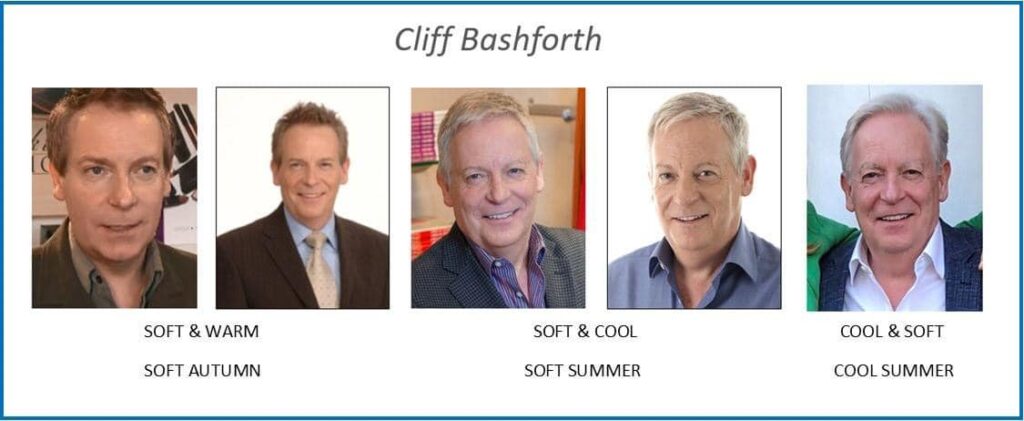Your hair, and specifically the colour of it, is often a huge topic of discussion during my colour analysis consultations!
I believe it plays an important part of your overall appearance, which is why I assess it during your colour analysis.
Over the years, I’ve seen many clients and heard lots of stories of how hair colour changes have an impact on what you wear. Whether it’s a choice of colouring your hair, ageing, or medical reasons like hair loss and cancer. They all have an impact.
Once you begin to notice that certain colours don’t look quite as good as they did, it’s worth determining if the reason is due to hair changes. If so, how permanent is it likely to be? You may be able to ‘weather the storm’ so to speak!
Skin tone
Worthy of note is that there’s a common misconception that the undertone of your skin doesn’t change as your age. Certainly, under the seasonal colour analysis system, you remain the same palette. However, I’ve seen plenty of examples where this isn’t the case.
The Colour Me Beautiful tonal colour analysis system which I use in my consultations, is more flexible as it recognises that as we get older, hair loses pigmentation, eyes become more muted, and skin becomes more transparent. These aspects will affect the impact of colour when you wear it.
The Colour Me Beautiful MD; Cliff Bashforth is a great example of this. Over the years, he has transitioned between palettes. Back in the early years of colour analysis, Cliff was an autumn. As the seasonal system was developed with CMB, he was a soft autumn Certainly, under the seasonal system, he would still be classified as someone with a warm skin tone, which he actually isn’t anymore. His overall features have changed.

Going grey
Along with Cliff, I have seen many clients over the years who have decided to embrace the grey! Revisit this blog here and take a look at Carol.
By way of another example, if you had dark brown hair in your younger years you’re likely to find that stronger, richer or bolder colours are now feeling and looking ‘too much’. They may be overwhelming your more delicate or softer appearance because the harmony between your hair, skin and eyes has changed.
Not all greys are the same either. There are ash tones, whites, silvers and salt and pepper. But, a colour analysis consultation can help to determine your best shades of colour and how to wear them.
Colouring your hair
Let’s say you were mousey and now have a more vibrant and striking red colour to your hair. The muted colours you will have looked amazing in previously are unlikely to have enough ‘bite’ or drama for you now. No doubt that if you’d been analysed previously, you’re likely to have stopped using your swatches some time ago! The key now is to match the intensity level of your hair with the colours you wear. Do be aware that red tones in the hair can be bold and bright or red and auburn and this difference can have an impact on the underlying hue of the colours which suit you best.
Medical reasons
This can be a very sensitive topic for people. Having worked with some cancer patients over the years, a result can often be hair loss. Many find that their hair grows back very differently! Resulting in a change to your appearance and therefore the colours which once loved you, might not love you the same now.
Deciding to embrace the no-hair look can be a brave move and I remember a client who had alopecia with the most remarkable pattern and design tattooed to her head for the summer. She found the heat was too unpleasant to wear her hair pieces.
Equally, hair pieces can transform your overall look in the same way. Choosing to go blonde, brunette, red or blue will all require an adaption if you want what you wear to harmonise with your features.
Wardrobe impact
If you have found that your hair colour changes are having an impact on your choice of colours and how they look, a wardrobe assessment might be in order.
Should the change be temporary, or you plan on frequently changing your hair colour, you may find yourself altering and updating your wardrobe frequently.
A more permanent change means it’s a good time to reassess your wardrobe and if what you have still works for you, or if you need to adapt it.
Be certain that it’s definitely the colour that’s not working for you, or if it could be the pattern/design/style/fit or material? These factors can also affect how ‘good’ something looks and how you feel.
Can you ‘rescue’ the colour by wearing it with another colour? Perhaps try a scarf or jewellery to break up the colour near to your face.
A piece of advice I give all my clients is to keep the ‘wrong’ colour away from your face and wear it on the bottom half. The impact of the colour will be far less severe when worn this way and you still get to wear and enjoy it.
Dyeing your clothes could be another option, especially if the fabric is not man-made. Synthetics don’t dye well at home (without major effort), but mixes still will (like polycotton).
For those that can’t be rescued and you decide to let them go, be clear about what colour you need to replace it with, if at all.
The impact of different shades of a colour
I always say that you can wear every colour. However, there is more than one shade, tint or tone of a colour!
I’ve recorded a video in which I show you examples of different tones of pink and greens against my features. I wanted to try and demonstrate the subtle difference in colours and how they would look different if my hair was different. You’ll find it on YouTube here.
A colour analysis consultation will help you with all the aspects discussed in this blog and shown in the video.

